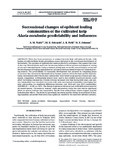Successional changes of epibiont fouling communities of the cultivated kelp Alaria esculenta: predictability and influences
| dc.contributor.author | Walls, AM | |
| dc.contributor.author | Edwards, MD | |
| dc.contributor.author | Firth, Louise | |
| dc.contributor.author | Johnson, MP | |
| dc.date.accessioned | 2017-04-24T17:06:19Z | |
| dc.date.available | 2017-04-24T17:06:19Z | |
| dc.date.issued | 2017-02-08 | |
| dc.identifier.issn | 1869-215X | |
| dc.identifier.issn | 1869-7534 | |
| dc.identifier.uri | http://hdl.handle.net/10026.1/9113 | |
| dc.description.abstract |
There has been an increase in commercial-scale kelp cultivation in Europe, with fouling of cultivated kelp fronds presenting a major challenge to the growth and development of the industry. The presence of epibionts decreases productivity and impacts the commercial value of the crop. Several abiotic and biotic factors may influence the occurrence and degree of fouling of wild and cultivated fronds. Using a commercial kelp farm on the SW coast of Ireland, we studied the development of fouling communities on cultivated Alaria esculenta fronds over 2 typical growing seasons. The predictability of community development was assessed by comparing mean occurrence-day. Hypotheses that depth, kelp biomass, position within the farm and the hydrodynamic environment affect the fouling communities were tested using species richness and community composition. Artificial kelp mimics were used to test whether local frond density could affect the fouling communities. Species richness increased over time during both years, and species composition was consistent over years with early successional communities converging into later communities (no significant differences between June 2014 and June 2015 communities, ANOSIM; R = -0.184, p > 0.05). The timing of species occurrences was predictable across years for all shared species. Variations in biomass, depth and position within the farm had no significant effect on species richness and composition. Results from artificial kelp mimics suggest possible hydrodynamic effects. The ability to understand succession and the timing of occurrences of fouling organisms and predict their arrival has significant benefits for the seaweed cultivation industry. | |
| dc.format.extent | 57-71 | |
| dc.language | en | |
| dc.language.iso | en | |
| dc.publisher | Inter-Research Science Center | |
| dc.subject | Alaria esculenta | |
| dc.subject | Macroalgae | |
| dc.subject | Aquaculture | |
| dc.subject | Frond | |
| dc.subject | Fouling | |
| dc.subject | Epibiont | |
| dc.subject | Predictability | |
| dc.subject | Influences | |
| dc.title | Successional changes of epibiont fouling communities of the cultivated kelp Alaria esculenta: predictability and influences | |
| dc.type | journal-article | |
| dc.type | Journal Article | |
| plymouth.author-url | https://www.webofscience.com/api/gateway?GWVersion=2&SrcApp=PARTNER_APP&SrcAuth=LinksAMR&KeyUT=WOS:000395686400006&DestLinkType=FullRecord&DestApp=ALL_WOS&UsrCustomerID=11bb513d99f797142bcfeffcc58ea008 | |
| plymouth.issue | 1 | |
| plymouth.volume | 9 | |
| plymouth.publication-status | Published | |
| plymouth.journal | Aquaculture Environment Interactions | |
| dc.identifier.doi | 10.3354/aei00215 | |
| plymouth.organisational-group | /Plymouth | |
| plymouth.organisational-group | /Plymouth/Faculty of Science and Engineering | |
| plymouth.organisational-group | /Plymouth/Faculty of Science and Engineering/School of Biological and Marine Sciences | |
| plymouth.organisational-group | /Plymouth/REF 2021 Researchers by UoA | |
| plymouth.organisational-group | /Plymouth/REF 2021 Researchers by UoA/UoA07 Earth Systems and Environmental Sciences | |
| plymouth.organisational-group | /Plymouth/Users by role | |
| plymouth.organisational-group | /Plymouth/Users by role/Academics | |
| dcterms.dateAccepted | 2016-12-14 | |
| dc.identifier.eissn | 1869-7534 | |
| dc.rights.embargoperiod | Not known | |
| rioxxterms.versionofrecord | 10.3354/aei00215 | |
| rioxxterms.licenseref.uri | http://www.rioxx.net/licenses/all-rights-reserved | |
| rioxxterms.licenseref.startdate | 2017-02-08 | |
| rioxxterms.type | Journal Article/Review | |
| plymouth.oa-location | http://www.int-res.com/abstracts/aei/v9/p57-71/ |


